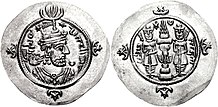Kavadh II
Kavadh II ( Persian غباد Ghobād [ ɢoˈbɔːd ]; * as Seroe or Siroe ; died September 628) was a Persian great king of the Sassanid dynasty who ruled in 628.
The Persian Great King Chosrau II (590–628) tried, under the influence of his Christian Queen Shirin , not to elect the eldest son Siroe, but her son Merdanschah as his successor. Siroe was the son of Chosraus' first wife Maria, who is referred to in some sources as the daughter of the Eastern Roman emperor Maurikios , but this is very unlikely.
As a result of the defeat of the great king against the Eastern Roman emperor Herakleios , Chosrau lost the support of part of the nobility and several leading officers. These now conspired against the king and also made contact with Siroe, who could only benefit from an overthrow. In February of the year 628 Khosrau was overthrown and Siroe ascended the throne as Kavadh II. A son of Chosraus' former financial advisor Yazdin , whom the great king had executed, was also involved in the coup . Chosrau was killed in prison in late February 628. Siroe also had Merdanschah and the other sons of Shirin murdered. Above all, however, he initiated peace negotiations with the Eastern Roman Empire; the content of a letter to Herakleios has come down to us through the Chronicon Paschale (Easter chronicle ).
However, Kavadh Siroe died after a few months in September of the year 628, so that the rumor arose that he had been poisoned by Shirin; however, it is possible that Shirin died before Kavadh. According to other reports, the king died in connection with an epidemic outbreak. A phase of turmoil of the throne began for the Persian Empire until Yazdegerd III. was able to bring the situation back under control, but soon followed the conquest of the empire by the Arabs (see Islamic expansion ).
The most important source for Kavadh's reign is the universal history of the Tabari , who made use of Sassanid reports that were lost in it. The above-mentioned Easter Chronicle , the author of Anonymus Guidi , the Armenian historian (pseudo-) Sebeos and the Byzantine chronicler Theophanes (AM 6118, 6119 and 6120) also deal with Kavadh.
literature
- Wilhelm Baum: Shirin. Christin - Queen - love myth. A woman from late antiquity - historical reality and literary impact. Klagenfurt 2003
- Touraj Daryaee: When the End is Near: Barbarized Armies and Barracks Kings of Late Antique Iran. In: Maria Macuch u. a. (Ed.): Ancient and Middle Iranian Studies. Harrassowitz Verlag, Wiesbaden 2010, pp. 43–52.
- Hodge Mehdi Malek: The coinage of the Sasanian king Kavad II (AD 628). In: The Numismatic Chronicle 155, 1995, pp. 120-130.
- John Martindale: The Prosopography of the Later Roman Empire IIIa . Cambridge 1992, pp. 276f.
Remarks
- ^ Ferdinand Justi: Iranian name book. Marburg 1895, p. 297.
- ↑ See John Martindale: The Prosopography of the Later Roman Empire IIIa . Cambridge 1992, p. 276.
- ↑ Theodor Nöldeke : History of the Persians and Arabs at the time of the Sasanids. From the Arab Chronicle of Tabari. Translated and provided with detailed explanations and additions . Leiden 1879, p. 361ff.
- ^ Theodor Nöldeke: The Syrian Chronicle published by Guidi, translated and commented . In: Meeting reports of the Imperial Academy of Sciences, phil.-hist. Class 128, 9 . Vienna 1893, pp. 29–31.
| predecessor | Office | successor |
|---|---|---|
| Chosrau II. |
King of the New Persian Empire 628 |
Ardashir III. |
| personal data | |
|---|---|
| SURNAME | Kavadh II |
| ALTERNATIVE NAMES | Siroe |
| BRIEF DESCRIPTION | Persian great king |
| DATE OF BIRTH | 6th century or 7th century |
| DATE OF DEATH | 628 |
